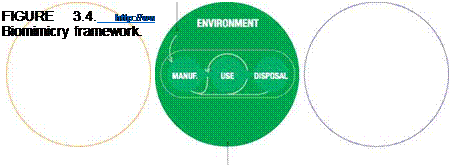 |
Like the Cradle to Cradle perspective, Biomimicry takes its inspiration from natural processes (see Figure 3.4). Promoted by Janine Benyus, Biomimicry isn’t so much a framework as it is an approach to re-imagining the design and development process. It is a perspective that searches for new ways of creating sustainable materials, products, services, and other solutions by learning how nature already works.
Strengths: Inspirational. Focused on nature’s accomplishments as both model and source of solutions.
Weaknesses: Incomplete, subjective metrics. The Design Spiral is a powerful procedural approach but is better at integrating into traditional development processes rather than replacing them.
Natural processes are incredible. The materials and processes already at work in nature rival and in many cases far surpass the complexity humans have managed to create. Janine Be – nyus is the founder of this perspective and the author of an excellent book by the same name, Biomimicry. In it, there are many examples of natural materials created by plants, animals, and other organisms that hold great promise for human solutions. As described previously, nature has no waste. In addition, some materials in nature rival what we’ve been able to create with our technical solutions. For example, silk is stronger than steel. Nature already has glues stronger than the best we’ve created and a host of other solutions we have much to learn from. Again, nature’s solutions are more efficient, more sustainable, and create no waste. Nature can serve both as a source of inspiration and a
source of materials and processes that we can use and emulate to create better, more sustainable solutions.
Biomimicry asks questions of designers and developers that open us to new answers:
• How does life make things? (Humans currently rely on heat, beat, and treat to solve problems.)
• How does life make the most of things? (Nature often adds information/data to its solutions to make them perform better.)
• How does life make things disappear things into systems? (Nature’s solutions aren’t isolated from their contexts.)
In addition, Janine Benyus has observed several principles of nature that can be effective guides to help us find new solutions: [11]
• Solar transformation (Many of natures solutions rely on the sun to power themselves.)
• Power of shape (The shape of molecules, organs, and organisms often powers nature’s solutions.)
• Color without pigments (Several of nature’s solutions use thin film interference to create color; for example, a chameleon’s ability to change its color to that of its surroundings, rather than its pigment.) [12]
• Green chemistry (Many of nature’s solutions are able to surpass ours without toxic chemistry.)
• Timed degradation (All of nature’s solutions disintegrate at some point, leaving building materials for other processes instead of waste.)
• Sensing and responding
• Growing fertility
• Life creates conditions conducive to life (Instead of toxic conditions that destroy life.) [13]
• Redundancy
• Cyclic solutions
• Diverse solutions



